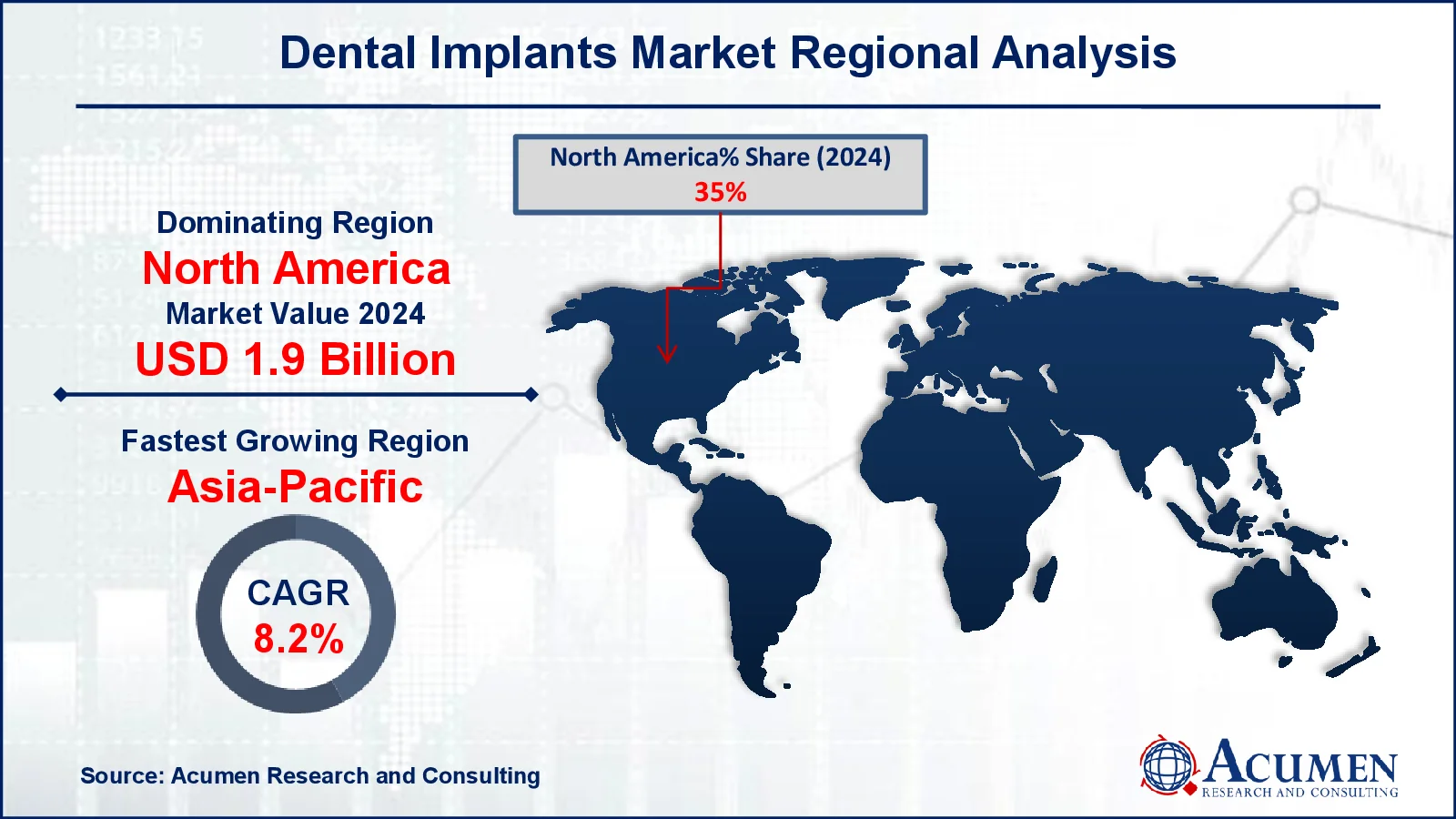Dental Implants Market Size - Global Industry, Share, Analysis, Trends and Forecast 2025 - 2033
Published :
Report ID:
Pages :
Format :
Dental Implants Market Size - Global Industry, Share, Analysis, Trends and Forecast 2025 - 2033
Report Coverage
- Industry Dynamics
- Market Size and Forecast Data
- Segment Analysis
- Competitive Landscape
- Regional Analysis with a Niche Focus on Country-Level Data
- High Level Analysis - Porter's, PESTEL, Value Chain, etc.
- Company Profiles of Key Players
- Option to Customize the Report As Per Your Specific Need
Request Sample Report
The Global Dental Implants Market Size accounted for USD 5.44 Billion in 2024 and is estimated to achieve a market size of USD 10.36 Billion by 2033 growing at a CAGR of 7.5% from 2025 to 2033.
Dental Implants Market Highlights
- The global dental implants market is projected to reach USD 10.36 billion by 2033, growing at a CAGR of 7.5% from 2025 to 2033
- The North American dental implants market was valued at approximately USD 1.9 billion in 2024
- In the United States, over 150 million people have at least one missing tooth, yet only about one million individuals receive treatment annually, leading to the placement of 2.5 million implants (American Academy of Implant Dentistry)
- The Asia-Pacific dental implants market is expected to grow at a CAGR of over 8.2% from 2025 to 2033
- Endosteal implants dominated the market in 2024, accounting for 74% of the total market share
- Titanium implants held a 91% market share in 2024, making it the most widely used material
- Technological advancements, such as 3D printing and digital workflows, improve implant customization and patient outcomes is a popular market trend that fuels the industry demand

A dental implant is an artificial tooth root that is implanted into the jawbone to support a replacement tooth or dental bridge. Dental implants are often composed of titanium and are intended for those who have lost teeth due to injury, periodontal disease, or other causes. These implants are made up of several components that provide long-term support for dentures, bridges, and crowns. They are best suited for adults because they are implanted after the jawbone has fully matured. There are several types of dental implants on the market, including endosteal, subperiosteal, and transosteal implants.
Global Dental Implants Market Dynamics
Market Drivers
- Increasing prevalence of dental disorders and tooth loss
- Advancements in implant technology (3D printing, biomaterials)
- Growing elderly population with higher dental care needs
Market Restraint
- High cost of dental implants and procedures
- Limited reimbursement policies in several regions
- Risk of implant failure and post-surgical complications
Market Opportunities
- Rising demand for cosmetic dentistry and aesthetic implants
- Growth in dental tourism, especially in emerging markets
- Increasing adoption of digital dentistry and AI-driven diagnostics
Dental Implants Market Report Coverage
|
Market |
Dental Implants Market |
|
Dental Implants Market Size 2024 |
USD 5.44 Billion |
|
Dental Implants Market Forecast 2033 |
USD 10.36 Billion |
|
Dental Implants Market CAGR During 2025 - 2033 |
7.5% |
|
Dental Implants Market Analysis Period |
2021 - 2033 |
|
Dental Implants Market Base Year |
2024 |
|
Dental Implants Market Forecast Data |
2025 - 2033 |
|
Segments Covered |
By Product, By Type, By Material, By End-User, and By Geography |
|
Regional Scope |
North America, Europe, Asia Pacific, Latin America, and Middle East & Africa |
|
Key Companies Profiled Aviation |
Glidewell Laboratories, Zimmer-Biomet, Cortex Dental Implants Industries Ltd., BioHorizons, ADIN Dental Implants Systems, Osstem Implant, Henry Schein, CAMLOG Biotechnologies AG, Biotech Dental, Danaher Corporation, A.B. Dental Devices Ltd., Avinent Implant System, Dentsply Sirona, Bicon LLC, and Institut Straumann AG. |
|
Report Coverage |
Market Trends, Drivers, Restraints, Competitive Analysis, Player Profiling, Covid-19 Analysis, Regulation Analysis |
Dental Implants Market Insights
The growing elderly population, together with the global prevalence of dental problems and periodontal diseases, is a primary driver of market expansion. According to the Centers for Disease Control and Prevention, tooth decay in permanent teeth is more common and severe in older teenagers (16-19 years, 12.1%) than younger adolescents (12-15 years, 8.6%). Furthermore, rising demand for cosmetic dentistry in North America and Europe is driving market growth. Advances in implant technology in wealthy countries, as well as increased disposable incomes in emerging economies, all contribute to market value.
Furthermore, the expansion of dental tourism in developing countries is likely to boost industry demand. For example, in October 2024, the GAOC Group collaborated with the Department of Tourism to improve Philippine dentistry and deliver high-quality dental care throughout Metro Manila. GAOC was the first dental tourism clinic recognized by the department's health and wellness program.
However, market expansion may be limited by the high cost of dental implants and rigorous reimbursement rules. Furthermore, the higher risk of tooth loss linked with dental bridges may limit extension. Nonetheless, increasing investments in computer-aided design (CAD) and computer-aided manufacturing (CAM) technology, along with the untapped potential of developing countries, are likely to generate considerable growth prospects in the coming years.
 Dental Implants Market Segmentation
Dental Implants Market Segmentation
The worldwide market for dental implants is split based on product, type, material, end-user, and geography.
Dental Implants Market By Product
- Tapered implants
- Parallel walled implants
According to dental implants industry analysis, tapered implants dominate the market because of their better stability and high success rates. Their conical shape facilitates early fastening, making them excellent for immediate installation and loading. These implants are especially effective in cases of low bone density because they allow better interaction with the jawbone. Additionally, its design reduces trauma during insertion, resulting in faster healing and better patient outcomes.
Dental Implants Market By Type
- Endosteal Implants
- Subperiosteal Implants
- Transosteal Implants
- Intramucosal implants
According to dental implants industry analysis, endosteal implants, the most frequent variety, involve surgically inserting screws, cylinders, or blades into the jawbone, making them excellent for patients who wear bridges or removable dentures. Subperiosteal implants, on the other hand, have a metal framework that sits on top of the jawbone and are advised for people who have low bone height and cannot wear traditional dentures. Transosteal implants are made of a U-shaped frame or metal pin that is pierced through the jawbone and extends into the gums. The primary distinction between subperiosteal and transosteal implants is that the former sits on top of the jawbone, while the latter is inserted behind the gums.
Dental Implants Market By Material
- Titanium
- Zirconium
According to dental implants industry analysis, titanium-based dental implants dominated the market in 2024 and are likely to continue to do so throughout the forecast period. This segment's growth is fueled by its compatibility with a variety of treatments, non-allergic qualities, and exceptional biocompatibility. Additionally, additional implant materials, such as zirconium, are used in the market.
Dental Implants By End-user
- Hospitals
- Dental clinics
- Others
According to dental implants market forecast, dental clinics lead the market because they provide primary care for the majority of dental operations, including implant placements. They provide specialized therapy, individualized care, and cost-effective solutions, making them the preferred option for patients. The availability of innovative technologies and qualified dental experts strengthens their market position. Hospitals, while also providing dental implant treatments, mostly handle difficult situations that necessitate surgical intervention or interdisciplinary therapy.
Dental Implants Market Regional Outlook
North America
- U.S.
- Canada
Europe
- U.K.
- Germany
- France
- Spain
- Rest of Europe
Asia-Pacific
- India
- Japan
- China
- Australia
- South Korea
- Rest of Asia-Pacific
Latin America
- Brazil
- Mexico
- Rest of LATAM
The Middle East & Africa
- South Africa
- GCC Countries
- Rest of the Middle East & Africa (ME&A)
 Dental Implants Market Regional Analysis
Dental Implants Market Regional Analysis
In terms of regional segments, North America dominates the dental implants industry, owing to extensive use of sophisticated dental technology and the strong presence of leading market participants. The region benefits from rising demand for cosmetic dentistry, increased knowledge of oral health, and an aging population that needs tooth replacements. For example, notably, the 2021 study Oral Health in America: Advances and Challenges stressed the need for significant improvements in the United States' oral healthcare system to alleviate inequities and enhance access to care. Recommendations such as making dental care a vital benefit and integrating oral and medical care help to drive market growth by increasing access to dental treatments like implants.
Asia-Pacific is fastest-growing region in dental implants market due to growing elderly population with higher dental care needs, and key market players and their focus on R&D in implants boost overall growth in Asian region.
Europe holds the notably growing in the dental implant industry and is expected to maintain its dominance throughout the forecast period. This growth is fueled by the strong presence of dental implant manufacturers, favorable reimbursement policies, and a rapidly expanding geriatric population. For instance, in May 2022, Osstem Implant launched the Key Solution (KS) implant, a next-generation implant system in Europe, further driving market expansion.
Dental Implants Market Players
Some of the top dental implants companies offered in our report include Glidewell Laboratories, Zimmer-Biomet, Cortex Dental Implants Industries Ltd., BioHorizons, ADIN Dental Implants Systems, Osstem Implant, Henry Schein, CAMLOG Biotechnologies AG, Biotech Dental, Danaher Corporation, A.B. Dental Devices Ltd., Avinent Implant System, Dentsply Sirona, Bicon LLC, and Institut Straumann AG.
Frequently Asked Questions
What was the market size of the global Dental Implants in 2024?
The market size of dental implants was USD 5.44 billion in 2024.
What is the CAGR of the global Dental Implants market from 2025 to 2033?
The CAGR of dental implants is 7.5% during the analysis period of 2025 to 2033.
Which are the key players in the Dental Implants market?
The key players operating in the global market are including Glidewell Laboratories, Zimmer-Biomet, Cortex Dental Implants Industries Ltd., BioHorizons, ADIN Dental Implants Systems, Osstem Implant, Henry Schein, CAMLOG Biotechnologies AG, Biotech Dental, Danaher Corporation, A.B. Dental Devices Ltd., Avinent Implant System, Dentsply Sirona, Bicon LLC, and Institut Straumann AG.
Which region dominated the global Dental Implants market share?
North America held the dominating position in dental implants industry during the analysis period of 2025 to 2033.
Which region registered fastest CAGR from 2025 to 2033?
Asia-Pacific region exhibited fastest growing CAGR for market of dental implants during the analysis period of 2025 to 2033.
What are the current trends and dynamics in the global Dental Implants industry?
The current trends and dynamics in the dental implants industry include increasing prevalence of dental disorders and tooth loss, advancements in implant technology (3d printing, biomaterials), and growing elderly population with higher dental care needs
Which type held the maximum share in 2024?
The endosteal implants held the maximum share of the dental implants industry.


